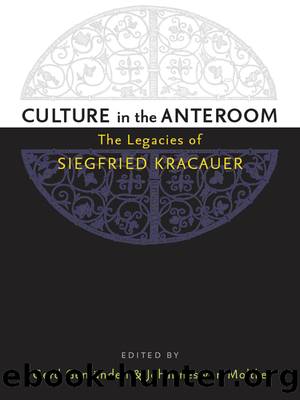Culture in the Anteroom by von Moltke Johannes;Gemünden Gerd;Gemünden Gerd;

Author:von Moltke, Johannes;Gemünden, Gerd;Gemünden, Gerd;
Language: eng
Format: epub
Publisher: University of Michigan Press
Kracauer's investigative method, relying on surface appearance to provide the clues for its own analysis, took the historical precedents provided by Semper and Riegl as given. He transferred the investigation from one of research into the past (that of his dissertation) to one with a contemporary focus (that of his critical work of the 1920s). At the same time, the raw material of his investigations also shifted from architecture and the decorative arts to more ephemeral surfaces that were beginning to receive the same intense scrutiny as remnant colored marble surfaces had received from nineteenth-century archaeologistsâthe new surfaces of photograph and film screen. If architecture had not provided enough purchase for his investigations, this was almost certainly connected to the top-down power structures of the profession until the tipping point of 1926, when control of the Werkbund and the Bund Deutscher Architekten (BDA) passed into the hands of younger architects more or less free of the control of the old Wilhelmine power brokers. At this point, and only then, could architects begin to engage contemporary mass culture in ways that might seem relevant to a population (and a journalist) growing increasingly enamored with the movie screen and the illustrated press. Mies van der Rohe became the vice president of the Werkbund in 1926 and was given the task of organizing the Stuttgart exhibition that struck Kracauer so forcibly. For a brief moment, Kracauer's two architectures came together. By the end of the decade, they were splitting apart again, when Kracauer, like Ernst Bloch and Behne, accused the radical project of the Neues Bauen as being unknowingly complicit with and obedient to the reductive rationalization of capitalism.32
In the opening of his long and interesting article on the exhibition in Stuttgart in 1927, Kracauer's tongue was seemingly in his cheek, as he celebrated the advanced condition of water faucets and bathroom fixturesâ harbingers of the new architecture (perhaps nodding to Adolf Loos, long an admirer of the advanced state of American and English plumbing). One of the greatest achievements of the full-scale buildings constructed on the Weissenhofsiedlung above Stuttgart was the fact that âthe bathtubs don't have to be ashamed of the dining room anymoreâ (die Badewannen brauchen sich der Speisezimmer nicht mehr zu schämen).33 No matter how skeptical, Kracauer's written remarks on the individual buildings of the Siedlung seem to indicate acceptance of the Neues Bauen, for better or worse, and recognition of the need for solidarity on the front of âthe new.â What attracted him most was the Glass Room at the materials exhibition downtown. This was a small installation commissioned by the German glass industry where plate glass walls subdivided the exhibition space with no other structural support. The walls were partially reflective; like mirrors, they brought filmic experience into real space and time, complicating present space through virtual projection, just as Kracauer had called for in âCult of Distraction.â In this space, architecture appeared and disappeared simultaneously. According to Kracauer, the installation was a marker for an architecture
Download
This site does not store any files on its server. We only index and link to content provided by other sites. Please contact the content providers to delete copyright contents if any and email us, we'll remove relevant links or contents immediately.
The Power of Myth by Joseph Campbell & Bill Moyers(1015)
Half Moon Bay by Jonathan Kellerman & Jesse Kellerman(956)
Inseparable by Emma Donoghue(941)
A Social History of the Media by Peter Burke & Peter Burke(940)
The Nets of Modernism: Henry James, Virginia Woolf, James Joyce, and Sigmund Freud by Maud Ellmann(836)
The Spike by Mark Humphries;(768)
The Complete Correspondence 1928-1940 by Theodor W. Adorno & Walter Benjamin(753)
A Theory of Narrative Drawing by Simon Grennan(746)
Culture by Terry Eagleton(725)
Ideology by Eagleton Terry;(699)
Bodies from the Library 3 by Tony Medawar(683)
World Philology by(679)
Farnsworth's Classical English Rhetoric by Ward Farnsworth(676)
Game of Thrones and Philosophy by William Irwin(671)
High Albania by M. Edith Durham(659)
Adam Smith by Jonathan Conlin(650)
A Reader’s Companion to J. D. Salinger’s The Catcher in the Rye by Peter Beidler(648)
Comic Genius: Portraits of Funny People by(618)
Monkey King by Wu Cheng'en(612)
